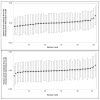The Intersections of Ethnicity, Nativity Status and Socioeconomic Position in Relation to Periodontal Status: A Cross-Sectional Study in London, England
- PMID: 34639818
- PMCID: PMC8508573
- DOI: 10.3390/ijerph181910519
The Intersections of Ethnicity, Nativity Status and Socioeconomic Position in Relation to Periodontal Status: A Cross-Sectional Study in London, England
Abstract
The role of migration as a social determinant of periodontitis has been overlooked. Intersectionality theory could help understand how immigration status interacts with other social determinants of health to engender inequalities in periodontitis. The objective of the present study was to evaluate whether ethnicity, nativity status and socioeconomic position intersect to structure social inequalities in periodontal status. Data from 1936 adults in a deprived and multi-ethnic area of London were analysed. The numbers of teeth with probing depth and clinical attachment loss were determined from clinical examinations. A matrix with 51 intersectional strata, defined according to ethnicity, nativity status and education, was created. A cross-classified multilevel analysis, with participants clustered within intersectional social strata, was performed to assess the extent to which individual differences in periodontal measures were at the intersectional strata level. A complex pattern of social inequalities in periodontal status was found, which was characterised by high heterogeneity between strata and outcome-specificity. The variance partition coefficient of the simple intersectional model, which conflated additive and interaction effects, indicated that 3-5% of the observed variation in periodontal measures was due to between-stratum differences. Moreover, the percentual change in variance from the simple intersectional to the intersectional interaction model indicated that 73-74% of the stratum-level variance in periodontal measures was attributed to the additive effects of ethnicity, nativity status and education. This study found modest evidence of intersectionality among ethnicity, nativity status and education in relation to periodontal status.
Keywords: ethnic groups; migration status; periodontal disease; socioeconomic position.
Conflict of interest statement
The authors declare no conflict of interest.
Figures


References
-
- Papapanou P.N., Sanz M., Buduneli N., Dietrich T., Feres M., Fine D.H., Flemmig T.F., Garcia R., Giannobile W.V., Graziani F., et al. Periodontitis: Consensus report of workgroup 2 of the 2017 World Workshop on the Classification of Periodontal and Peri-Implant Diseases and Conditions. J. Periodontol. 2018;89((Suppl. 1)):S173–S182. doi: 10.1002/JPER.17-0721. - DOI - PubMed
-
- Bernabe E., Marcenes W., Hernandez C.R., Bailey J., Abreu L.G., Alipour V., Amini S., Arabloo J., Arefi Z., Arora A., et al. Global, Regional, and National Levels and Trends in Burden of Oral Conditions from 1990 to 2017: A Systematic Analysis for the Global Burden of Disease 2017 Study. J. Dent. Res. 2020;99:362–373. - PMC - PubMed
MeSH terms
LinkOut - more resources
Full Text Sources

